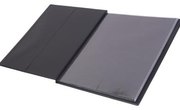An advanced degree in philosophy opens doors in many fields, including writing, journalism, publishing, public relations, law, mediation, teaching, educational and corporate administration, counseling, management and even computer careers. Good philosophy MA and PhD programs draw many applicants, so your application materials must be first-rate. Along with high GRE scores, glowing recommendations and a strong academic background, developing the most effective curriculum vitae, or CV, for your application can help you gain entry into the graduate school philosophy program you desire.
Place your name and contact information, including address, phone and email, at the top of the CV. Type this information in a header so it will appear on each page.
Develop a section covering your education, listing your degrees, schools and dates of attendance. Organize the information in reverse chronological order, with the most recent first. Include details that emphasize your academic ability, such as a high GPA and any merit scholarships you may have received.
Create an academic projects section cataloging publications, presentations, internships and philosophy coursework you have completed. Place these details in bullet format, in reverse chronological order.
Type a section for your work history. List employers, positions held and dates in reverse chronological order. Include two or three bullet points with each to illustrate how you used your leadership skills, thinking ability, organization and ability to multi-task.
Include a section for extra-curricular campus and community activities. List those that illustrate your interest in philosophy, logic, management and writing -- any that show your ability to succeed in a graduate program in philosophy.
Add other sections as the particular graduate school requires, such as awards, memberships or certifications.
Arrange the information on the CV so the most significant information appears first. If you recently graduated from college and have little work experience, the education portion should likely appear first. If you have a long and relevant employment history, put that portion at the top. Use formatting changes such as font size, bold, italics and underlining to differentiate concepts and devise a pleasing, easy-to-read document. The content should logically flow from one point to the next, and new sections should be immediately recognizable.
Proofread the CV. Run a spell check and read through the document for errors the program may miss, such as the spelling of names. Create parallel grammatical structures and use punctuation correctly throughout the curriculum vitae.
Related Articles
References
Writer Bio
Kristie Sweet has been writing professionally since 1982, most recently publishing for various websites on topics like health and wellness, and education. She holds a Master of Arts in English from the University of Northern Colorado.











